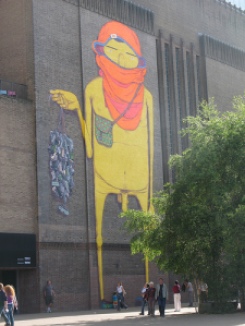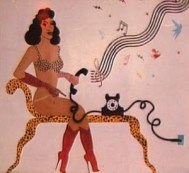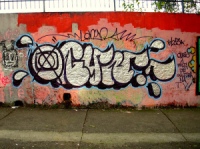
Brazil has a long love affair with graffiti, from the omnipresent pichações – that frequently depict the name of the gang that claims that territory – to acclaimed art.
It all began in the 70’s, as a reaction to the censorship imposed by the military dictatorship. Even today, it frequently makes political statements. Check below this pichação in São Paulo. It crosses the round logo of the powerful Rede Globo, the main media complex in the country. And shouts: “I hate the lack of culture on TV! “.
Alex Vallauri, the Ethiopian-born artist who died in 1987, was the Brazilian’s equivalent of Keith Haring, who gave graffiti Art status in the US. Not many of Vallauri’s graffiti survived, but his universe – inhabited by kitsch images, sexy women and high-heeled boots – inspired the new generations of street artists.
These days, the raising stars in the Brazilian graffiti scene are Os Gêmeos (Otávio e Gustavo Pandolfo), two identical twins from São Paulo. They helped redefine the national style and are spreading their brand around the world. “The New York Times” describes their work as “rococo, fantastic and epic”. Last year they created a mural in the front of the Tate Modern museum, in London, together with another Brazilian grafiteiro, Nunca, and a few artists from other countries. Check this interview for some insights on their creation process.
If you want to learn more about Brazilian graffiti, visit this really cool selection on Flick. You can also find some interesting content in this book: Graffiti Brasil (Street Graphics / Street Art).



Thank you for mentioning Alex and his importance to the transformation of tagging into high art. I was Alex’s partner in NYC, and still have so many of his unique stencil designs, posters, letters, paintings, stickers, and even one of his ‘acrobat’ ashtrays.
I am so glad that Alex continues to be appreciated.
It is wonderful to have your feedback, Brian. It is tough for artists to keep their memories alive – but it is even tougher for graffiti artists, for obvious reasons. I grew up surrounded by Vallauri´s work, which is extremely connected to São Paulo´s identity (a mix of sexy, fake, kitsch that expresses this “cute ugly metropolis” vibe). If you have any images you could share with me, I would love to publish them here in the future.
I’ll be happy to share some photos with you!
I haven’t yet labeled all of them, but will.
Photos:
http://picasaweb.google.com/BJKPMA/AlexVallauriArtPhotos?feat=directlink
Video of some artifacts:
Great video, Brian! I will definitely use one of the pictures in my “Deep Art” in a few days. Thanks for sharing.